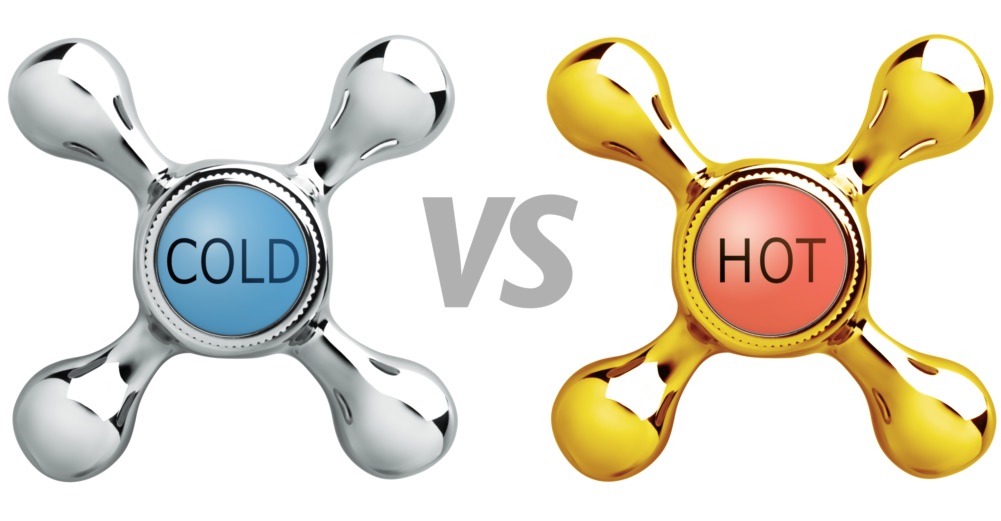Ice versus Heat for Pain and Injury
When to use ice, when to heat, when not to, and why
There is soooo much confusion about this issue. It’s a shame because therapeutic icing and heating — cryotherapy and thermotherapy — are rational, cheap, easy, safe self-treatment options for many common painful problems. This article gives you a bird’s eye view of the issues, with links to other articles with as much detail as you could possibly want, especially the main icing article, the main heating article, and the please-beware-of-icing-back-pain article.

What ice and heat are for
Ice is for fresh injuries, and heat is for stiff, aching muscles. Roughly. But the devil is in the details, and there are a lot of them.
Ice is for injuries — calming down damaged superficial tissues that are inflamed, red, hot and swollen. The inflammatory process is a healthy, normal, natural process … that also happens to be incredibly painful and more biologically stubborn than it needs to be. Icing is mostly just a mild, drugless way of dulling the pain of inflammation and taking swelling down a bit … we hope.1 Examples: a freshly pulled muscle or a new case of IT band syndrome (which is more likely to respond than the other kind of runner’s knee, patellofemoral pain, because ITBS is superficial and PFPS is often a problem with deeper tissues).
Heat is for muscles, chronic pain, and stress — taking the edge off symptoms like muscle aching and stiffness, which have many unclear causes,2 but trigger points are probably one of the usual suspects.3 Chronic pain, especially back pain, often involves lots of tension, anxiety, hypervigilance, and sensitization, and comfortable heat can soothe a jangled mind and nervous system. Stress and fear are major factors in many painful problems, of course.
Alternating between applications of ice and heat is called contrasting therapy. It’s extremely stimulating and is mostly used to facilitate injury recovery, with unknown efficacy.
What ice and heat are not for
Both ice and heat have the potential to do some minor, temporary harm when used poorly. Heat can make inflammation significantly worse. Ice can aggravate symptoms of tightness and stiffness; it can also just make any pain worse when it’s unwanted.
Both ice and heat are pointless or worse when unwanted: icing when you’re already shivering, or heating when you’re already sweating. The brain may interpret an excess of either one as a threat, but icing is more threatening — and when brains think there’s a threat, they may also amp up the pain.4 Ice seems to be feel more threatening to most people.
Be especially wary of icing muscle pain — and it may not be obvious. You may think your back is injured, for instance, but it may “just” be muscle pain. Trigger points (painfully sensitive spots) can be surprisingly intense and easily mistaken for “iceable” injury and inflammation. But if you ice trigger points, they may burn and ache even more acutely. This mistake is made particularly often with low back pain and neck pain — the very conditions people often try to treat with ice.
Heat and inflammation are the other particularly bad combination. If you add heat to a fresh injury, watch out: it’s going to get worse! A physician once told my father to heat a freshly injured knee, and wow — it swelled up like a balloon, three times bigger than it had been before. And three times more painful.5
What about injured muscle? Muscle strains?
If you’re supposed to ice injuries, but not muscle pain, then what do you do with injured muscles (a muscle tear or muscle strain)? That can be a tough call, but ice usually wins — but only for the first few days at most, and only if it really is a true muscle injury. A true muscle injury usually involves obvious trauma during intense effort, causing severe pain suddenly. If the muscle is truly torn, then use ice to take the edge off the inflammation at first. Once the worst is over, switch to heat.
Is ice better than heat? Is heat better than ice?
Ideal uses of ice and heat are roughly equal in potency — which isn’t very potent. Neither is strong medicine. Some experiments have shown that both have only mild benefits, and those benefits are roughly equal in treating back pain.6 The reason to use them is not that they are highly effective treatments — they rarely are — but because they are so cheap, easy, and mostly safe, especially compared to many other popular treatments.7
The bottom line
The bottom line is: use whatever feels best to you! Your own preference is the tie-breaker and probably the most important consideration. For instance, heat cannot help if you already feel unpleasantly flushed and don’t want to be heated. And ice is unlikely to be effective if you have a chill and hate the idea of being iced!
If you start to use one and you don’t like the feel of it … just switch to the other.
Much, much more hot and cold information
Other closely related topics:
- Contrast Hydrotherapy — “Exercising” tissues with quick changes in temperature, to help with pain and injury rehab (especially repetitive strain injuries).
- Icing, Heating & Tissue Temperature — How much do ice packs and heating pads change the temperature of deeper muscle and joints?
About Paul Ingraham

I am a science writer in Vancouver, Canada. I was a Registered Massage Therapist for a decade and the assistant editor of ScienceBasedMedicine.org for several years. I’ve had many injuries as a runner and ultimate player, and I’ve been a chronic pain patient myself since 2015. Full bio. See you on Facebook or Twitter., or subscribe:
What’s new in this article?
2017 — Added several clarifications and footnotes, especially about heating for muscle stiffness and pain.
2007 — Publication.
Notes
- Collins NC. Is ice right? Does cryotherapy improve outcome for acute soft tissue injury? Emerg Med J. 2008 Feb;25(2):65–8. PubMed 18212134 ❐
This is a 2008 review of just 6 studies of therapeutic icing, only two of them any good: one with slightly positive results, the other showing no effect. So that’s two studies that showed little or no benefit, which is leaning towards bad news, but it’s just not enough data to clinch it. (Four animal studies showed reduced swelling, but we can’t take animal studies to the bank.) The bottom line is just that “there is insufficient evidence.”
- Words like “spasm” and “tension” imply that muscle is the problem, but it’s scientifically unclear what actually causes symptoms like stiffness, aching, or sensitive spots in our soft tissues. Spasticity is an interesting and instructive extreme: prolonged severe muscle tension caused by things like spinal cord irritation, either mechanical or pathological (multiple sclerosis). A lot of body discomfort is probably caused by milder versions of spasticity: “tension” with many possible causes. For more on this interesting topic, see Cramps, Spasms, Tremors & Twitches.
- “Trigger points” are hypothetical micro-cramps, persistent tiny patches of contracted muscle tissue, a possible mechanism for (very) common muscle pain. Their existence/biology is controversial, but the symptoms of soreness and focal sensitivity are not: people definitely have this kind of pain all the time, and is often even quite severe and completely lacking in any other apparent cause. So something is going on, and all that is in doubt is the nature of the beast, but there is a great deal of doubt about that! See Trigger Point Doubts.
- Ice feels more “threatening” to most people, and pain is fundamentally the sensation of danger. If the brain thinks there’s trouble, pain ramps up. Unwanted cooling can increase the brain’s concern, and thus pain. See Pain is Weird.
- That is a rare example of a particularly severe negative reaction to heat. Most cases are not going to be that bad!
- Garra G, Singer AJ, Leno R, et al. Heat or cold packs for neck and back strain: a randomized controlled trial of efficacy. Acad Emerg Med. 2010 May;17(5):484–9. PubMed 20536800 ❐
What’s better for neck and back pain — ice or heat? This experiment, conducted at a university-based emergency department, compared the effectiveness of these two common treatments. Everyone studied received 400mg of ibuprofen orally and then thirty patients were given a half hour of either a heating pad or a cold pack.
The researchers concluded that adding heat or cold to ibuprofen therapy did not change the result. Both heat and cold resulted in “mild yet similar improvement in the pain severity.” They recommend that the “choice of heat or cold therapy should be based on patient and practitioner preferences and availability.”
This study has major limitations. These were patients with pain so strong they went to the hospital, so many of them may have been well beyond the help of a hot pack or ice pack. And the ibuprofen was a significant confounding factor.
- For instance, many popular over-the-counter pain medications have much more serious side effects than most people are aware of. Or a hands-on therapy like chiropractic spinal manipulation may be slightly effective for acute spinal pain, but only slightly effective and they also backfire surprisingly often (see Paige 2017) and they involve significant costs and time. Icing and heat are dramatically safer and more accessible.
Permalinks
PainSci Member Login » Submit your email to unlock member content. If you can’t remember/access your registration email, please contact me. ~ Paul Ingraham, PainSci Publisher
Found! 🙂 Member content on this page only has just been unlocked. To unlock member content on all other pages for a month, see the confirmation email just sent. (If it doesn’t turn up in your inbox, check your spam folder! Email can also sometimes take a few minutes. If it never turns up, just contact me.)
Found! But… You have a PainSci account, but this content cannot be unlocked, because you do not have an active PainSci membership with perks for that. You may have have a basic membership and/or access to books only. For more information, see your account page or confirmation email (just sent).
Not found! 🙁 Sorry, but that email address is not in the PainSci database.
⚠️ Sorry, server is overwhelmed at the moment. This is a very rare error. It should go away if you try again in a little bit.